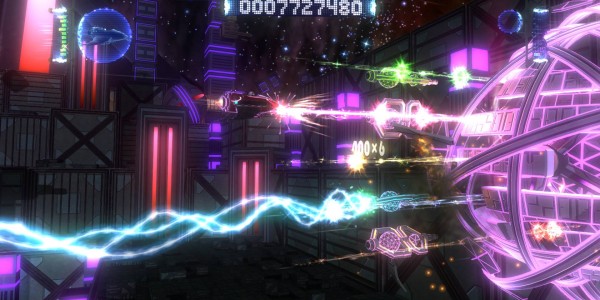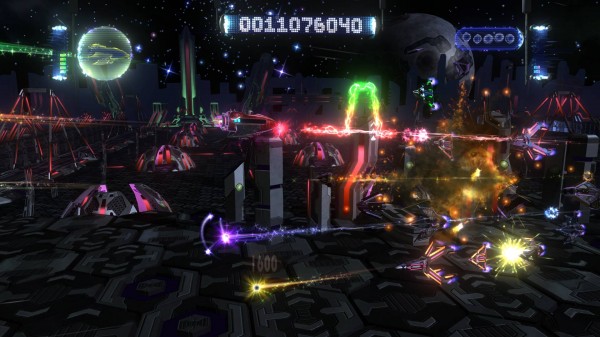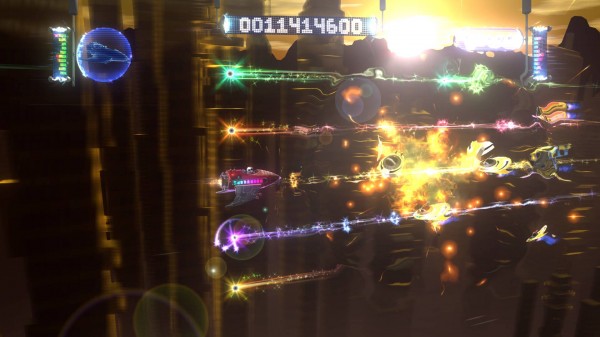When Retro/Grade starts, it ends.
The game begins just as our hero, Rick Rocket, defeats its final boss. However, as the credits begin to roll, the continuing explosion Rick caused rips a hole in the time space continuum (or so I assume) and sets everything in reverse. Then the game actually begins.
Retro/Grade is played backwards, each level scrolling from behind. While it may seem like a space shooter similar to Gradius or R-Type, it’s a rhythm game. There are up to five different colored tracks Rick can hop between depending on difficulty. So if you still have hundreds of dollars of Guitar Hero and/or Rock Band peripherals lying around, Retro/Grade invites you sync them back up and get strumming.
Much of the game I spent ignoring and, somewhat, missing. The construct is that as you play backwards, the bullets, missiles and other weapons you fired from your ship are now going in reverse and must be collected. Meanwhile, the shots fired by your enemies – of which there are a variety – are sneaking up from behind you. Avoid, collect, and dance. Unlike most rhythm games, though, Retro/Grade never felt like it was too difficult to control.
The course for collecting my ammo, let’s just call them orbs for continuity’s sake, was laid out. As long as I followed it, I never got hit. It makes sense, but it limits the game’s rhythm threat. I’d often zone everything else out and focus on just my orbs. There weren’t any solo guitar riffs to master or double-timing to learn. The game stayed on a smooth, neat track. There were a few off-beat orbs that made me stumble, but any of those instances were remedied by the game’s time-rewinding toggle. Any error could be undone by turning time backward. Or forward, I guess.
The challenge was keeping my eyes from glossing over and succumbing to all the flashy-flashy extravagance. Retro/Grade has so much energy and flow it makes Speed Racer’s special effects look dull. Enemy weaponry advances as the game comes to an end at its beginning. And just to hush those out there who would question why things would become more difficult as you went back to what would technically be the beginning of Rick’s mission, 24 Carat Games gives an explanation in the pre-mission text. (All those messages should be read too. They’re hilarious.)
It was the music, though, that kept my pace through all the motion and overwhelming retinal gauntlet. The dulcet beats, which didn’t always match up to the orbs, were always refreshing to listen to each time I played a level. Like my faithful pilot Rick, I kept my head nodding as a way to keep the fireworks-in-a-tornado display from pummeling me. At times I’d be praying for the level to be over. It wasn’t boring or repetitious. It was sensory overload.
To help parse the quick but fulfilling 10-level whirlwind of lights and sound, Retro/Grade also has a Challenge mode that mixes up difficulties and level conditions. It’s displayed like a Mario world map, with warps and different pathways. The remixes and changes unlock cheats and other ship types.
Retro/Grade turns the clock back to around four years ago when plastic guitars were a common sight in gaming households. It revives the kinetic breakdown of rhythm games with a glossy, fun, techno feast. I haven’t played Guitar Hero or Rock Band in several years, so it was nice picking up a Genericaster (which I had to borrow from a friend, as my inventory of gaming instruments has vanished into obscurity). I forgot the challenge of remembering the color patterns and having to hop back up on beat if I faulted. This type of gameplay has been absent from my gaming experiences lately. I’m glad I was able to turn back the clock and give it another go. And the music couldn’t have been any better.




















